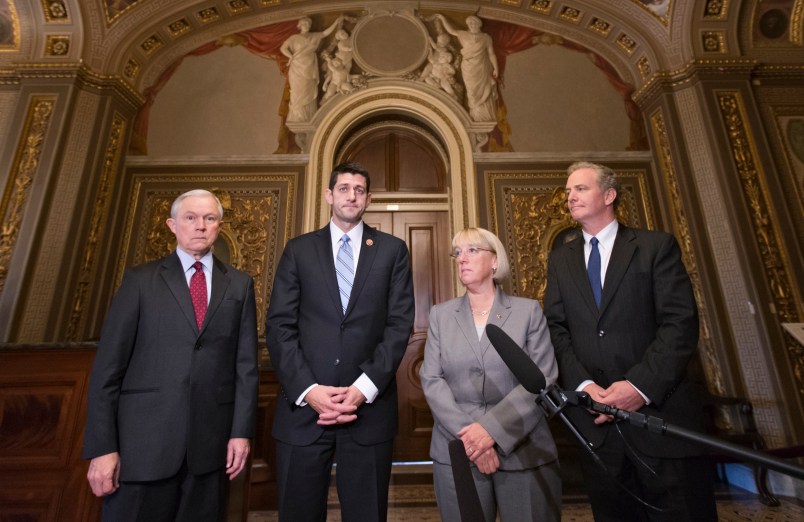On Wednesday morning the joint House-Senate Budget committee will convene for its first session. The group, led by Senate Budget Committee Chairwoman Patty Murray (D-WA) and House Budget Committee Chairman Paul Ryan (R-WI) has until Dec. 13 to make its report on recommendations that will then go to the full House and Senate. The committee is charged with finding a compromise between the two chamber’s versions of a spending plan for fiscal 2014. Perhaps before they start the debate, they should ponder this chart of the labor force participation rate.

In the early 1970s the participation rate began to climb as more and more women entered the workforce. It peaked when George Bush entered office and has been on the decline ever since. As the New York Times’ David Leonhardt has pointed out, this has very little to do with Baby Boomer retirement. The economist Daniel Alpert has argued in his new book, The Age of Oversupply, that “the central challenge facing the global economy is an oversupply of labor, productive capacity and capital relative to the demand for all three.”
Viewed through this lens, neither the policy prescriptions of Republicans nor Democrats are capable of changing the dynamic brought about by the entrance of three billion new workers into the global economy in the last 20 years. Republican fears that U.S. deficits will lead to Weimar-like hyper-inflation ring hollow in a country where only 63 percent of able-bodied adults are working. Democrats hectoring for the Fed and the banks to loan more to business to stimulate the economy are equally nonsensical when American corporations are sitting on $2.4 trillion in cash. A recent Gartner survey suggests the trend of lower labor participation rates is just getting started as digitization begins to wipe out the service economy.
Digitization is reducing labor content of services and products in an unprecedented way, thus fundamentally changing the way remuneration is allocated across labor and capital. Long term, this makes it impossible for increasingly large groups to participate in the traditional economic system — even at lower prices — leading them to look for alternatives such as a bartering-based (sub)society, urging a return to protectionism or resurrecting initiatives like Occupy Wall Street, but on a much larger scale. Mature economies will suffer most as they don’t have the population growth to increase autonomous demand nor powerful enough labor unions or political parties to (re-)allocate gains in what continues to be a global economy.
This dystopian vision of large scale social unrest and barter economies is a little too close to the summer science fiction film Elysium for my taste, but if we think we can continue on a path where the plutocrats prosper while real jobs are increasingly scarce, we are engaged in magical thinking.
But there is a way out of this deflationary trap we are in. First the Republicans have got to acknowledge the obvious: America’s corporations are not going to invest in vast amounts of new capacity when there is a glut of capacity in almost every sector worldwide. Secondly, that overcapacity is not going to get absorbed until more people go back to work and start buying the goods from the factories. This was the same problem our country faced in the great depression and the way we got out of it was by putting people to work rebuilding the infrastructure of this country. Did it ever occur to the politicians in Washington that the reason so many bridges, water and electrical systems are failing is because most of them were built 80 years ago, during the great depression. For Republicans to insist that more austerity will bring back the “confidence fairy” is exactly the wrong policy prescription for an age of oversupply. But equally destructive, as Paul Krugman points out are Democratic voices like Erskine Bowles, shouting from any venue that will pay him, that the debt apocalypse is upon us.
What is needed is investment in the infrastructure of the next economy. Investors buying tax-free municipal bonds to rebuild ancient water systems and bridges as well as solar and wind plants will finance much of it. But just as President Eisenhower understood that a national interstate highway system built in the 1950s would lead to huge productivity gains in the 1960s and 1970s, the Federal government will have to play a large part in rebuilding America. As we wind down our trillion dollar commitments to wars in the Middle East, we must engage in an Economic Conversion Strategy from permanent war to peaceful innovation that both liberals and libertarians could embrace. I doubt that the congressional leaders understand the urgency of this task as they gather on Wednesday, but if they did, the country could begin a road back to full employment.
Taplin is a professor at the Annenberg School for Communication at the University of Southern California and the Director of the USC Annenberg Innovation Lab.






